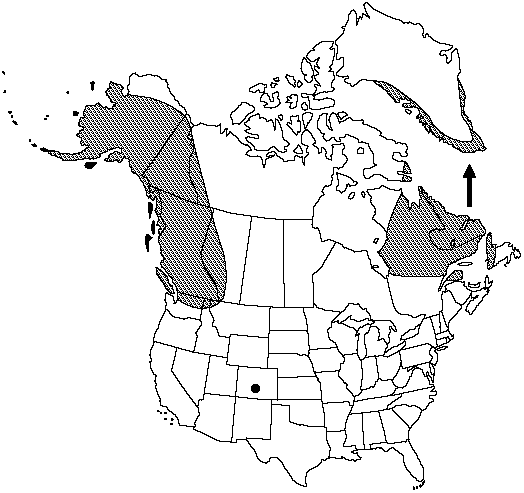Difference between revisions of "Diphasiastrum alpinum"
Preslia 47: 107. 1975.
FNA>Volume Importer |
GeoffLevin (talk | contribs) m (Fixed Nfld. and Labr. distribution to match printed version.) |
||
| (8 intermediate revisions by 3 users not shown) | |||
| Line 8: | Line 8: | ||
}} | }} | ||
|common_names=Alpine club-moss;lycopode alpin | |common_names=Alpine club-moss;lycopode alpin | ||
| − | |basionyms={{Treatment/ID/ | + | |basionyms={{Treatment/ID/Basionym |
|name=Lycopodium alpinum | |name=Lycopodium alpinum | ||
|authority=Linnaeus | |authority=Linnaeus | ||
| + | |rank=species | ||
| + | |publication_title=Sp. Pl. | ||
| + | |publication_place=2: 1104. 1753 | ||
}} | }} | ||
|synonyms= | |synonyms= | ||
| Line 24: | Line 27: | ||
-->{{Treatment/Body | -->{{Treatment/Body | ||
|habitat=Dry conifer or mixed forests, grassy mountain slopes. | |habitat=Dry conifer or mixed forests, grassy mountain slopes. | ||
| − | |distribution=Greenland;Alta.;B.C.;Nfld.;N.W.T.;Que.;Yukon;Alaska;Colo;Idaho;Mont.;Wash.;Europe;Asia in Japan. | + | |distribution=Greenland;Alta.;B.C.;Nfld. and Labr.;N.W.T.;Nunavut;Que.;Yukon;Alaska;Colo.;Idaho;Mont.;Wash.;Europe;Asia in Japan. |
| − | |discussion=<p>The branchlet leaves of Diphasiastrum alpinum are unique in the genus, and the trowel-shaped underside leaves with their flared and rolled blades and contracted bases are particularly unusual. The leaves of the other North American species are much simpler in shape and contour.</p> | + | |discussion=<p>The branchlet leaves of <i>Diphasiastrum alpinum</i> are unique in the genus, and the trowel-shaped underside leaves with their flared and rolled blades and contracted bases are particularly unusual. The leaves of the other North American species are much simpler in shape and contour.</p> |
|tables= | |tables= | ||
|references= | |references= | ||
| Line 34: | Line 37: | ||
-->{{#Taxon: | -->{{#Taxon: | ||
name=Diphasiastrum alpinum | name=Diphasiastrum alpinum | ||
| − | |||
|authority=(Linnaeus) Holub | |authority=(Linnaeus) Holub | ||
|rank=species | |rank=species | ||
| Line 42: | Line 44: | ||
|family=Lycopodiaceae | |family=Lycopodiaceae | ||
|habitat=Dry conifer or mixed forests, grassy mountain slopes. | |habitat=Dry conifer or mixed forests, grassy mountain slopes. | ||
| − | |distribution=Greenland;Alta.;B.C.;Nfld.;N.W.T.;Que.;Yukon;Alaska;Colo;Idaho;Mont.;Wash.;Europe;Asia in Japan. | + | |distribution=Greenland;Alta.;B.C.;Nfld. and Labr.;N.W.T.;Nunavut;Que.;Yukon;Alaska;Colo.;Idaho;Mont.;Wash.;Europe;Asia in Japan. |
|reference=None | |reference=None | ||
|publication title=Preslia | |publication title=Preslia | ||
|publication year=1975 | |publication year=1975 | ||
|special status= | |special status= | ||
| − | |source xml=https:// | + | |source xml=https://bitbucket.org/aafc-mbb/fna-data-curation/src/2e0870ddd59836b60bcf96646a41e87ea5a5943a/coarse_grained_fna_xml/V2/V2_464.xml |
|genus=Diphasiastrum | |genus=Diphasiastrum | ||
|species=Diphasiastrum alpinum | |species=Diphasiastrum alpinum | ||
Latest revision as of 20:24, 20 February 2024
Horizontal stems mainly shallowly buried, 0.5–3 mm wide, sometimes emerging, 1.1–2.2 mm wide; leaves appressed, spatulate to lanceolate, 1.5–3.8 × 0.5–1.4 mm, apices truncate. Upright shoots 6–14 cm, clustered, fasciculate, branching successively 3–5 times; leaves on upright main stem ascending, deltate-ovate, 3.5–4 × 0.8 mm, apices needlelike. Branchlets square in cross section, 1.8–4 mm wide, annual bud constrictions abrupt and conspicuous; underside often glaucous, concave; upperside green, dull to faintly shiny, convex. Leaves on branchlets 4-ranked, overlapping; upperside leaves appressed, lanceolate, 3–5.8 mm, free portion of blades 1.7–2.9 × 0.1–1.1 mm; lateral leaves strongly divergent, 3.3–6.5 × 1.8–2.4 mm, margins revolute; underside leaves well developed, perpendicular to stem, 1.3–3.3 × 0.6–1.3 mm, unique in genus in having base contracted, blade flaring, and margins becoming parallel. Peduncles absent. Strobili solitary, 5–30 × 2–4 mm, sterile tips absent. Sporophylls deltate to nearly cordate, 2.2–3.5 × 1.6–3 mm, apices gradually tapering. 2n = 46.
Habitat: Dry conifer or mixed forests, grassy mountain slopes.
Distribution

Greenland, Alta., B.C., Nfld. and Labr., N.W.T., Nunavut, Que., Yukon, Alaska, Colo., Idaho, Mont., Wash., Europe, Asia in Japan.
Discussion
The branchlet leaves of Diphasiastrum alpinum are unique in the genus, and the trowel-shaped underside leaves with their flared and rolled blades and contracted bases are particularly unusual. The leaves of the other North American species are much simpler in shape and contour.
Selected References
None.